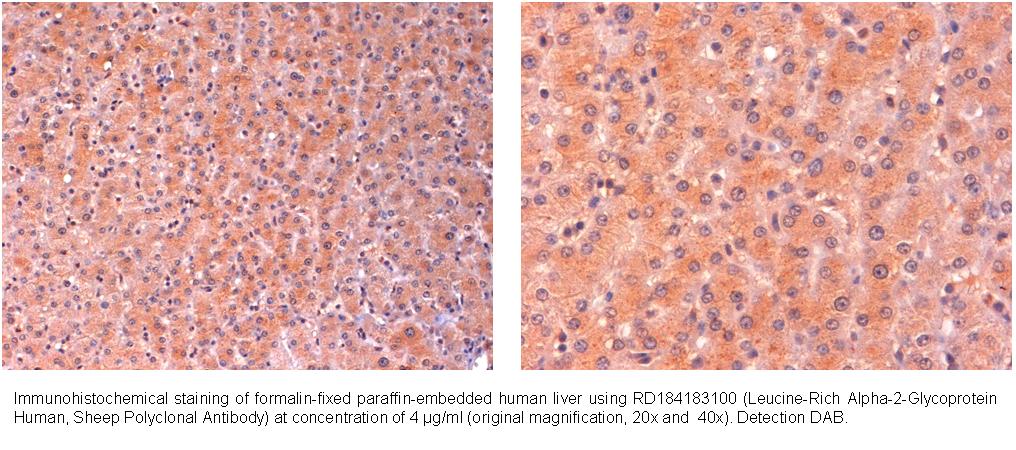Type
Polyclonal Antibody
Applications
Western blotting, Immunohistochemistry
Antibodies Applications
Source of Antigen
Human pooled serum
Hosts
Sheep
Preparation
The antibody was raised in sheep by immunization with the native Human LRG.
Amino Acid Sequence
Native protein isolated from pooled human serum, 312 AA. MW: 34.35 kDa (calculated without glycosylation). Protein identity confirmed by LC-MS/MS (NCBI no. gi|16418467).
VTLSPKDCQVFRSDHGSSISCQPPAEIPGYLPADTVHLAVEFFNLTHLPANLLQGASKLQELHLSSNGLESLSPEFLRPVPQLRVLDLTRNALTGLPPGLFQASATLDTLVLKENQLEVLEVSWLHGLKALGHLDLSGNRLRKLPPGLLANFTLLRTLDLGENQLETLPPDLLRGPLQLERLHLEGNKLQVLGKDLLLPQPDLRYLFLNGNKLARVAAGAFQGLRQLDMLDLSNNSLASVPEGLWASLGQPNWDMRDGFDISGNPWICDQNLSDLYRWLQAQKDKMFSQNDTRCAGPEAVKGQTLLAVAKSQ
Species Reactivity
Human. Not yet tested in other species.
Purification Method
Immunoaffinity chromatography on a column with immobilized native Human LRG.
Antibody Content
0.1 mg (determined by BCA method, BSA was used as a standard)
Formulation
The antibody is lyophilized in 0.05 M phosphate buffer, 0.1 M NaCl, pH 7.2.
Reconstitution
Add 0.2 ml of deionized water and let the lyophilized pellet dissolve completely. Slight turbidity may occur after reconstitution, which does not affect activity of the antibody. In this case clarify the solution by centrifugation.
Shipping
At ambient temperature. Upon receipt, store the product at the temperature recommended below.
Storage/Expiration
The lyophilized antibody remains stable and fully active until the expiry date when stored at -20°C. Aliquot the product after reconstitution to avoid repeated freezing/thawing cycles and store frozen at -80°C. Reconstituted antibody can be stored at 4°C for a limited period of time; it does not show decline in activity after one week at 4°C.
Quality Control Test
Indirect ELISA – to determine titer of the antibody
SDS PAGE – to determine purity of the antibody
BCA - to determine quantity of the antibody
Note
This product is for research use only.
Research topic
Sepsis
Summary
Leucine-rich alpha-2-glycoprotein (LRG) is a secretory type 1 acute phase protein whose expression is upregulated by the mediators of acute-phase response. The level of LRG in the blood increases during microbial infections and cancer, presumably as a result of the liver’s response to pro-inflammatory cytokines . The function of LRG is unknown but it is proved that LRG is tightly binding to Cyt C. It is suggested that extracellular Cyt C that is released from the cell death by an acute inflammation could be trapped to form tight complex with LRG and be excluded from circulation. LRG secretion by human hepatoma cells is increased by treatment with a mixture of cytokines including IL-6, IL-1b, and TNFα that are known to induce acute-phase proteins. It is known that LRG plays a role in adhesive interactions between lymphocytes and the endothelium. LRG may aid in the control of granulopoiesis by helping to modulate the surface expression of different receptor types, including transforming growth factor receptor, granulocyte-macrophage colony-stimulating factor receptor and possibly the macrophage colony stimulating factor receptor. LRG normal plasma concentration is approximately of 21 µg/ml based on purification, or ~50 µg/ml measured by ELISA. Human LRG is a serum glycoprotein of 312 amino acids in length with a predicted unmodified molecular weight of 34 to 36 kDa. SDS PAGE results show LRG molecular weight ranges from 44 to 55 kDa with isoelectric points ranging from 4.52 to 4.72, suggesting that 3 of 30 modifications occur. Leucine-rich alpha-2-glycoprotein consists of a single polypeptide chain with one galactosamine and four glucosamine oligosaccharides attached. The polypeptide has two intrachain disulfide bonds and contains 312 amino acid residues of which 66 are leucine. The amino acid sequence can be exactly divided into 13 segments of 24 residues each, eight of which exhibit a periodic pattern in the occurrence of leucine, proline, and asparagine.

